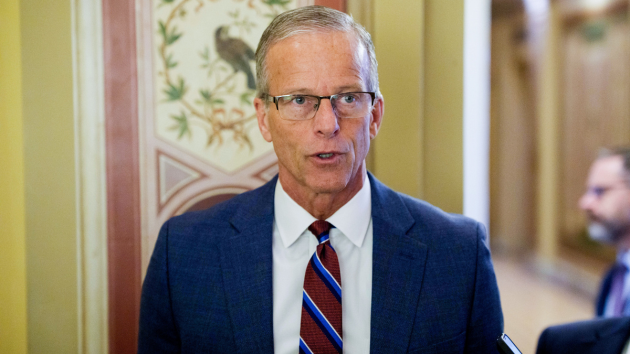Dogsledding terrain is turning to mush: How climate change forces Iditarod to adapt
Written by ABC Audio. All rights reserved. on March 15, 2024
(ANCHORAGE, Alaska.) — For the first time in 25 years of running dogsledding tours, Tanya McCready must invest in snowmaking equipment.
The vanishing snow along the trails she mushes her sled dogs and the once frozen lake she says is no longer safe to cross signify a changing climate — and the shortest winter season in her career.
“We’ve talked about it for years,” McCready, co-owner of Winterdance Dogsled Tours in Canada and author of “Journey of 1000 Miles: A Musher and His Huskies’ Journey on the Yukon Quest’s Century Old Klondike Trails,” told ABC News. “But this year, we can’t put off the financial impact of not being able to control the snow any longer, it’s just too huge.”
Dogsledding has transitioned from a once-vital form of transportation in snow-covered regions to a popularized cross-country recreation that commemorates the history of the North.
But as the effects of climate change impact the iciest of landscapes, experts say dogsledding recreation and competition have faced several obstacles and grown more dangerous as the terrain diminishes and the weather warms.
“When you live in an area where the weather impacts the economics of your business, you’re just so cognizant of all the changes over 10, 20 years,” McCready said. “It impacts your running schedule and your training schedule because you have to stop when it’s too warm for the dogs.”
Increased temperatures, lack of snow and ground changes have forced the Iditarod Trail Dog Sled Race, a longstanding Alaskan competition, to adapt to its changing environment.
Alaska has warmed more than twice as rapidly as the contiguous United States with average annual air temperature increasing by 3 degrees Fahrenheit and average winter temperatures rising by 6 degrees Fahrenheit, according to the National Climate Assessment.
The 52nd annual Iditarod began on March 2 and saw victory on March 12 when Dallas Seavey completed the competition in nine days, two hours, and 16 minutes. The Iditarod continues until every team crosses the finish line.
“Oh, gosh, this year’s journey has been a combination of a lot of different events, and it’s not even finished yet,” Chas St. George, Chief Operations Officer of Iditarod Trail Committee, told ABC News.
The Iditarod sees teams of dogs and mushers travel a grueling 1,000-mile course across the Alaskan wilderness. The race historically runs from Anchorage to Nome to commemorate the 20 dogsled teams that traveled the route in 1925 to deliver medicine amid a diphtheria epidemic.
However, several years of snowpack and climate challenges have led Iditarod officials to create a “restart” where the race now begins in Willow, Alaska, a small town over 72 miles north of Anchorage.
“Willow is an area where the climate has been fairly consistent and gives us more snow there,” St. George said, adding that the race’s official start time moved from 10:00 a.m. to 2:00 p.m. to help the sled dogs acclimate
“The nights are cooler and the days are warmer, especially this time of year. So that time change enabled the dogs to acclimate as they were running.”
To ensure the Iditarod trail has enough snowpack for safe sledding, St. George says Anchorage and Willow stockpile snow that is then trucked out along the path ahead of the race.
“It is totally snow recycling,” St. George said, noting that keeping the Alaskan ecosystem intact amid the race is a top priority for the Iditarod Trail Committee and the Iditarod Historic Trail Alliance.
“If we’re not going to walk our talk and take the lead on what’s relevant and important to this ecosystem that we are a part of, then we’re not going to survive,” he said.
St. George, who has worked with the Iditarod Trail Committee since 2004, explained how the effects of climate change have been evident throughout his career in Alaska.
“We seem to think of it as a slow process, but it’s not. It is very, very important to note that we have seen these kinds of changes, spikes in climate,” St. George said. “And that is the definition of climate change.”
This year’s Iditarod race ended in tragedy for three sled dogs, who all collapsed and died along the trail despite life-saving efforts by on-site veterinarians, according to race officials.
Iditarod officials said initial necropsies have not provided causes of death for the dogs.
People for the Ethical Treatment of Animals (PETA) has repeatedly called for sled dog racing, and specifically the Iditarod race, to be stopped, calling the arduous 1,000-mile competition “animal abuse.”
“A small portion of the Iditarod trail this year was actually expected to be bare because of a lack of snow,” Melanie Johnson, a senior campaign manager with PETA, claimed to ABC News. “But that didn’t prevent mushers from dangerously forcing dogs to race on it.”
Johnson hopes that the effects of climate change are considered in sled dogs’ welfare, saying, “The climate catastrophe has made dogsledding in some areas more difficult or even impossible. The dogs who are forced to spend their lives on the end of a chain and run until their bodies break down can’t wait any longer.”
From the 1,000-mile trek through the Alaskan wilderness to McCready’s dogsled tour through the Canadian forests, rising temperatures are threatening the future of a centuries-old practice, something McCready believes is a “huge part of our history.”
“We don’t need to dog sled, we don’t need to ride horses, but just because these things that were such a huge part of our history aren’t needed, it doesn’t mean that they’re not still incredible experiences,” McCready said. “You can’t be around dogsledding and not see how much everyone absolutely just lives to do it — dogs and people.”
For McCready, the impact of climate change on professional dogsledding races is disheartening and she urges people to experience it while they have the chance.
“You know, with climate change, who knows how much longer these events will be able to keep going,” McCready said. “So, if it’s on your list, don’t put it off.”
Copyright © 2024, ABC Audio. All rights reserved.





